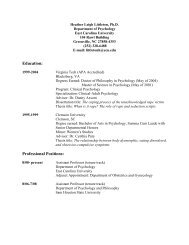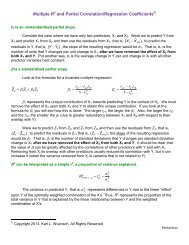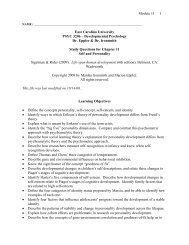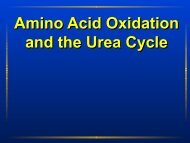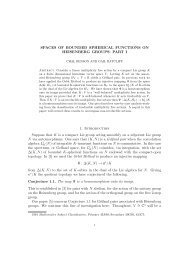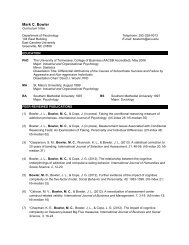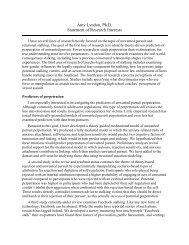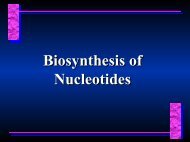Defining and Measuring Trophic Role Similarity in Food Webs Using ...
Defining and Measuring Trophic Role Similarity in Food Webs Using ...
Defining and Measuring Trophic Role Similarity in Food Webs Using ...
You also want an ePaper? Increase the reach of your titles
YUMPU automatically turns print PDFs into web optimized ePapers that Google loves.
318J. J. LUCZKOVICH ET AL.Everett, M.G.&Borgatti, S. P. (1991). <strong>Role</strong> colour<strong>in</strong>ga graph. Math. Soc. Sci. 21, 183–188.Everett, M. G. & Borgatti, S. P. (1994). Regularequivalence: General theory. J. Math. Soc. 19, 29–52.Everett, M. G. & Borgatti, S. P. (1996). Exactcolorations of graphs <strong>and</strong> digraphs. Soc. Networks 18,319–331.Goldwasser, L.&Roughgarden, J. (1993). Construction<strong>and</strong> analysis of a large Caribbean food web. Ecology74, 1216–1233.Goodenough, W. H. (1969). Reth<strong>in</strong>k<strong>in</strong>g ‘‘status’’ <strong>and</strong>‘‘role’’: toward a general model of the cultural organizationof social relationships. In Cognitive Anthropology(Tyler, S. A., ed.), pp. 311-330. New York: Holt,R<strong>in</strong>ehart, <strong>and</strong> W<strong>in</strong>ston.Hirata, H. & Ulanowicz, R. E. (1985). Informationtheoretical analysis of the aggregation <strong>and</strong> hierarchicalstructure of ecological networks. J. theor. Biol. 116,321–341.Homans, G. C. (1950). The Human Group. New York:Harcourt, Brace, <strong>and</strong> World.Homans, G. C. (1961). Social Behavior: Its ElementaryForms. New York: Harcourt, Brace, <strong>and</strong> World.Hutch<strong>in</strong>son, G. E. (1958). Conclud<strong>in</strong>g remarks. ColdSpr<strong>in</strong>g Harbor Symp. Quant. Biol. 22, 415–427.Jaccard, P. (1900). Contribution au problame de l’immigrationpost-glaciaire de la flore alp<strong>in</strong>e. Bull. Soc.Vaudoise Sci. Nat. 36, 87–130.Jackson,J.B.C.,Kirby,M.X.,Berger,W.H.,Bjorndal,K. J., Botsford, L. W., Bourque, B. J., Bradbury, R.H., Cooke, R., Erl<strong>and</strong>son, J., Estes, J. A., Hughes,T. P., Kidwell, S., Lange, C. B., Lenihan, H. S., P<strong>and</strong>olfi,J. M., Peterson, C. H., Steneck, R. S., Tegner,M. J. & Wa r n e r, R. H. (2001). Historical overfish<strong>in</strong>g <strong>and</strong>the recent collapse of coastal ecosystems. Science 293,629–638.Johnson, J. C., Borgatti, S. P., Luczkovich, J. J. &Everett, M. G. (2001). Network role analysis <strong>in</strong> thestudy of food webs: an application of regular rolecoloration. J. Soc. Struct. 2, on-l<strong>in</strong>e: http://www.he<strong>in</strong>z.cmu.edu/project/INSNA/joss/<strong>in</strong>dex1.html.Johnson, S. C. (1967). Hierarchical cluster<strong>in</strong>g schemes.Psychometrika 32, 241–253.L<strong>in</strong>deman, R. L. (1942). The trophic–dynamic aspect ofecology. Ecology 23, 399–418.Lorra<strong>in</strong>,F.&White, H. C. (1971). Structural equivalenceof <strong>in</strong>dividuals <strong>in</strong> networks. J. Math. Soc. 1, 49–80.Luczkovich, J. J., Ward, G. P., Johnson, J. C., Christian,R. R., Baird, D., Neckles, H. & Rizzo, B.Determ<strong>in</strong><strong>in</strong>g the trophic guilds of fishes <strong>and</strong> macro<strong>in</strong>vertebrates<strong>in</strong> a seagrass food web. Estuaries, <strong>in</strong> press.Mayhew, B. (1980). Structuralismvs. <strong>in</strong>dividualism.Part 1: shadow box<strong>in</strong>g <strong>in</strong> the dark. Soc. Forces 59,335–375.Merton, R. K. (1959). Social Theory <strong>and</strong> Social Structure.New York: Free Press.Nadel, S. F. (1957). The Theory of Social Structure.New York: Free Press.Perrson, L., Bengtsson, J., Menge, B. A. & Power,M. E. (1996). Productivity <strong>and</strong> consumer regulation Fconcepts, patterns, <strong>and</strong> mechanisms. In: <strong>Food</strong> <strong>Webs</strong>:Integration of Patterns <strong>and</strong> Dynamics. (Polis, G. &W<strong>in</strong>emiller, K. O., eds), pp. 396–434. Chapman & Hall.New York, NY, U.S.A.Root, R. B. (1967). The niche exploitation pattern of theblue-gray gnatcatcher. Ecol. Monogr. 37, 317–350.Starke, P. H. (1972). Abstract Automata. Amsterdam:North Holl<strong>and</strong> Publish<strong>in</strong>g Company, Elsevier.Stil<strong>in</strong>g, P. (2002). Ecology: Theories <strong>and</strong> Applications.Upper Saddle River, NJ: Prentice-Hall.Ulanowicz, R. E. (1986). Growth <strong>and</strong> Development:Ecosystems Phenomenology. New York: Spr<strong>in</strong>ger-Verlag.White, H. C. (1963). An Anatomy of K<strong>in</strong>ship. EnglewoodCliffs, NJ: Prentice-Hall.White, H.C.&Reitz, K. P. (1983). Graph <strong>and</strong> semigrouphomomorphisms on networks of relations. Soc. Networks5, 193–235.Yo dzi s, P. (1988). The <strong>in</strong>determ<strong>in</strong>acy of ecological <strong>in</strong>teractionsas perceived through perturbation experiments.Ecology 69, 508–515.Yo dzi s, P. & W<strong>in</strong>emiller, K. O. (1999). In search ofoperational trophospecies <strong>in</strong> a tropical aquatic food web.Oikos 87, 327–340.APPENDIX AA list of the species of <strong>in</strong>sects <strong>and</strong> compartments<strong>in</strong> the Malaysian pitcher plant topologicalfood web (Beaver, 1985), taken fromStil<strong>in</strong>g(2002).(1) Misumenops nepenthicola, (2) Encyrtid(near Trach<strong>in</strong>aephagus), (3) Toxorhynchies klossi,(4) Lestodiplosis sy<strong>in</strong>gopais, (5) Megaselianepenth<strong>in</strong>a, (6) Endonepenth<strong>in</strong>ia schuitemakeri,(7) Triperoides tenax, (8) Triperoides bambusa,(9) Dasyhelea nepenthicola, (10) Nepenthosyrphussp., (11) Pierretia urceola, (12) Culex curtipalpis,(13) Culex lucaris, (14) Anotidae sp. 1, (15)Anotidae sp. 2, (16) bacteria <strong>and</strong> protozoa, (17)live <strong>in</strong>sects, (18) recently drowned <strong>in</strong>sects <strong>and</strong>(19) older organic debris.APPENDIX BA list of the identification codes <strong>and</strong> compartmentnames for the St. Marks seagrass carbonflowfood web taken fromBaird et al. (1998). SeeChristian & Luczkovich (1999) for a completespecies list with<strong>in</strong> each compartment.(1) Phytoplankton, (2) Halodule wrighti, (3)micro-epiphytes, (4) macro-epiphytes, (5)benthic algae, (6) bacterio-plankton, (7) microprotozoa,(8) zooplankton, (9) epiphyte-graz<strong>in</strong>gamphipods, (10) suspension-feed molluscs, (11)suspension-feed polychaetes, (12) benthic bacteria,



